Basketball Tryout Plan PDF: A Comprehensive Guide
A comprehensive basketball tryout plan in PDF format serves as a roadmap for coaches. It helps them efficiently evaluate players. The plan incorporates drills targeting dribbling, passing, shooting, and defensive skills. It also assesses athleticism, focus, and coachability. The aim is to select a well-rounded and engaged team.

Key Elements of a Basketball Tryout
Successful basketball tryouts hinge on several key elements. A well-structured plan is paramount, incorporating a mix of drills and scrimmages to assess diverse skills. Drills should evaluate dribbling proficiency, passing accuracy, shooting form, and defensive capabilities. Coaches must observe players’ athleticism, speed, quickness, and overall court awareness during these drills.
Furthermore, tryouts should gauge a player’s focus, desire, and coachability. Engaged athletes who readily absorb new instructions are invaluable assets. It is also crucial to document each tryout meticulously. This documentation helps justify team selections and provides a reference point for future player development. Conditioning drills should also be included to evaluate players’ stamina and endurance.
Consider incorporating offensive set instruction to observe how quickly players grasp new concepts. Create a fair and effective process, ensuring all participants have ample opportunity to showcase their abilities. Ultimately, a well-executed tryout identifies not only skilled players but also those with the potential to grow and contribute positively to the team’s dynamic.
Essential Tryout Drills for Player Evaluation
Effective player evaluation during basketball tryouts relies on a selection of essential drills targeting fundamental skills. Layup drills, such as the two-line layup drill, assess shooting form and efficiency near the basket. Passing drills, including move-and-pass exercises, evaluate accuracy and decision-making while in motion. Defensive drills, like the shuffle and scoop, gauge footwork, agility, and defensive positioning.
Dribbling drills, such as full-court dribble-moves drills, are vital for assessing ball-handling skills under pressure. Incorporating 2-on-2 box-out drills evaluates rebounding technique and physicality. Conditioning drills, like shuttle runs or suicides, determine players’ endurance and stamina. Integrating a quick release drill measures shooting speed and accuracy from various spots on the court.
It is important to observe players’ performance, but also their attitude and work ethic during each drill. Evaluate not only their skill execution, but also their ability to listen to instructions and implement feedback. These essential drills will help coaches identify well-rounded players with a strong foundation in fundamental basketball skills and the potential for further development.
Dribbling Drills for Tryouts
Dribbling drills are crucial during basketball tryouts for assessing a player’s ball-handling proficiency, control, and agility. A fundamental drill is the cone dribbling drill, which evaluates a player’s ability to navigate obstacles while maintaining control of the ball. The figure-eight dribble tests agility and coordination as players weave through cones in a figure-eight pattern.
Full-court dribbling drills, such as the full-court dribble-moves drill, assess a player’s speed, endurance, and ability to execute dribbling moves under pressure while advancing down the court. Incorporating variations like crossover dribbles, behind-the-back dribbles, and between-the-legs dribbles challenges players’ dexterity and creativity. The “Chill Drill” emphasizes dribbling control and path navigation.
Another effective drill involves combining dribbling with passing, allowing coaches to observe a player’s ability to transition seamlessly between ball-handling and distribution. Coaches should also focus on proper hand placement, head-up awareness, and the ability to dribble effectively with both hands. Evaluating these elements within dribbling drills provides valuable insights into a player’s overall ball-handling capabilities and potential contribution to the team.
Passing Drills for Tryouts
Passing drills are essential during basketball tryouts to gauge players’ court vision, accuracy, and decision-making skills. A basic two-player passing drill, where players pass continuously while moving, assesses their ability to deliver accurate passes at varying distances. Coaches can observe form, speed, and the ability to lead a receiver.
Adding variations like chest passes, bounce passes, and overhead passes challenges players’ adaptability and technique. Fast-break drills, such as 2-on-0, 2-on-1, and 2-on-2 scenarios, emphasize quick decision-making and precise passing under pressure. The ability to execute these passes while maintaining speed is crucial.
Furthermore, incorporating passing drills that involve movement and cutting enhances players’ understanding of spacing and timing. Drills where players pass and follow their pass, or make a cut to receive the ball back, simulate game-like situations and reveal their ability to integrate passing into offensive flow. Coaches should evaluate accuracy, technique, decision-making, and the ability to pass effectively with both hands to gain a comprehensive understanding of each player’s passing capabilities. Proper footwork and body positioning during passing are also important factors to consider.
Shooting Drills for Tryouts
Shooting drills are vital for basketball tryouts, revealing a player’s scoring ability and shooting mechanics. Start with fundamental drills like form shooting from close range, focusing on proper technique, release, and follow-through. Progress to spot-up shooting from various locations on the court, assessing accuracy and consistency. Incorporate drills that simulate game-like shots, such as shooting off the dribble, catch-and-shoot scenarios, and shooting after making a cut.
Evaluate players’ ability to shoot under pressure by adding defensive elements to the drills. Contested shots and quick-release drills highlight their composure and adaptability. Include free-throw shooting to gauge concentration and consistency. Analyze shooting percentages from different spots to identify strengths and weaknesses. Observe players’ shooting form, footwork, and the arc of their shots.
Additionally, assess their ability to create their own shot and make shots from beyond the three-point line. Evaluate their shot selection and decision-making in different situations. Coaches should look for players who demonstrate a consistent shooting form, a quick release, and the ability to make shots under pressure, as these are essential qualities for successful shooters.
Defensive Drills for Tryouts
Defensive drills are crucial for evaluating a player’s commitment to the less glamorous but equally important side of basketball. Begin with stance and movement drills, assessing their ability to maintain a low, balanced stance and move laterally quickly. Include defensive shuffling drills to evaluate footwork and agility. Progress to close-out drills, emphasizing the proper technique for approaching an opponent and preventing them from driving to the basket.
Incorporate 1-on-1 defensive drills to assess individual defensive skills, such as staying in front of the opponent, contesting shots, and preventing penetration. Add rebounding drills to evaluate their ability to box out and secure rebounds. Include team defensive drills, such as help-side defense and rotations, to assess their understanding of team concepts and their ability to communicate effectively on defense.
Evaluate players’ willingness to dive for loose balls and take charges, as these actions demonstrate their commitment and toughness. Observe their ability to anticipate passes and intercept the ball, as well as their ability to pressure the ball handler. Coaches should look for players who display a high level of effort, a strong understanding of defensive principles, and a willingness to sacrifice for the team.

Conditioning Drills for Tryouts
Conditioning drills are essential to gauge a player’s physical fitness and stamina, critical components for enduring the demands of a basketball game. Start with warm-up laps and dynamic stretching to prepare the players’ muscles. Incorporate shuttle runs to assess speed, agility, and endurance, measuring their ability to quickly change direction and maintain pace. Implement suicides, a classic basketball conditioning drill, to test their sprinting ability and mental toughness.
Include interval training, alternating between high-intensity bursts and periods of rest, to simulate the stop-and-go nature of basketball. Integrate line drills, requiring players to sprint back and forth between lines, to evaluate their speed and stamina. Add plyometric exercises, such as jump squats and box jumps, to assess explosive power and lower body strength. Include core strengthening exercises to improve stability and prevent injuries.

Observe the players’ ability to maintain proper form and technique throughout the drills, as fatigue can often lead to breakdowns. Evaluate their mental resilience and determination, as conditioning drills can be physically and mentally challenging. Coaches should be looking for players who demonstrate a high level of fitness, a strong work ethic, and the ability to push themselves even when fatigued.

Evaluating Player Attributes Beyond Skills
While basketball skills are undeniably important, evaluating intangible player attributes is crucial for building a successful team. Observe players’ court awareness, their ability to anticipate plays, and make smart decisions; Assess their coachability by noting how well they respond to instruction and implement feedback. Teamwork is paramount; evaluate their ability to collaborate, communicate effectively, and support teammates. Look for leadership qualities, such as the ability to motivate others, take initiative, and lead by example.
Evaluate their attitude and sportsmanship, observing how they handle adversity, interact with opponents, and respect the rules of the game. Assess their work ethic and hustle, paying attention to their effort level, determination, and willingness to go the extra mile. Evaluate their basketball IQ, their understanding of the game, offensive and defensive strategies. Assess their mental toughness, their ability to stay focused, composed, and resilient under pressure.
Observe their body language and non-verbal communication, looking for signs of confidence, enthusiasm, and positive energy. Consider their overall fit within the team dynamic, assessing how their personality and character align with the team’s culture. Remember that a player with exceptional skills but lacking in these intangible attributes may not be as valuable as a player with solid skills and outstanding character.
